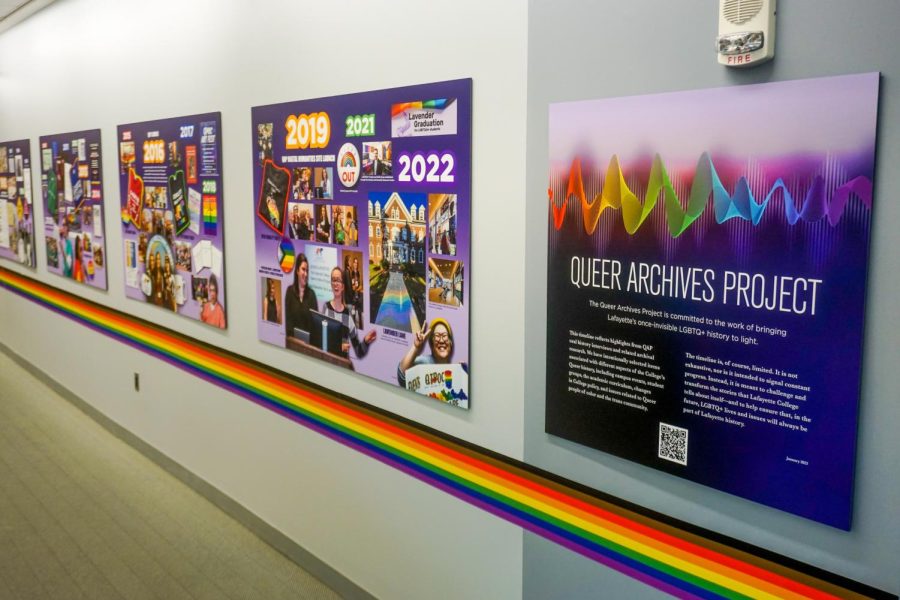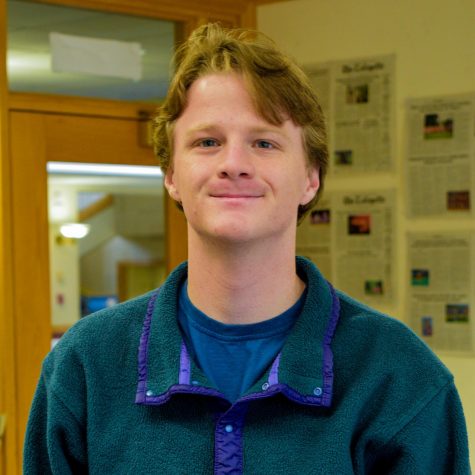After years of detailed research, interviews and campus-wide collaboration, the Lafayette Queer Archives Project (QAP) is showcasing its work with a new exhibit.
Mary Armstrong, director of the QAP and professor of English and women’s, gender and sexuality studies, called the project a “celebration of courage, but also a call to action that we can do better.”
With the help of college archivist Elaine Stomber and director of Digital Scholarship Services Charlotte Nunes, as well as EXCEL scholars Cia Negron ‘23, Reilly Hughes ‘23 and several students in previous years, Armstrong has developed several extensive components of the QAP.
The most recent component, an exhibit entitled “Queer Pasts, Queer Futures: The Lafayette Queer Archives Project,” is a physical timeline of data and stories selected by the QAP team. From now until June 4, the exhibit will be displayed on the first floor of Skillman Library.
“The exhibition in Skillman celebrates the LGBTQ+ alumni, faculty and staff from 1959 to 2016 who have generously participated in the oral history interviews that shape the Queer Archives Project. It offers a pathway into their stories and experiences and encourages dialogue about LGBTQ+ issues and queer history at Lafayette and beyond,” Stomber said.
“I want people to see the timeline and understand that this is just a sliver of the LGBTQ+ history here at Lafayette. It encompasses some of the most discussed themes recorded in our interviews but the full picture is so much larger and richer,” Hughes said.
“Every person who reads that history should think, ‘What is my job for tomorrow? If this is what yesterday looked like … what is my responsibility for tomorrow to make this an antiracist, non-misogynist, queer-friendly campus?’ … I hope it inspires people to ask themselves that question and then to act,” Armstrong said.
According to Nunes, the work of the QAP extends far beyond this display.
“The exhibit is one culmination of a multi-pronged, yearslong collaboration among WGSS and units at the library – specifically, College Archives and Digital Scholarship Services,” Nunes added.
The QAP team meets for two hours each week to determine what research would be most helpful to the project, such as keeping track of interviews, uncovering the themes from the oral histories and inputting data.
“Because a big part of activism is the educational aspect of it and visibility … I think the QAP does just that,” Negron said. “It’s making those resources readily available. Being completely honest about people’s experiences at Lafayette gives people the platform to speak and be heard … a lot of them haven’t been able to voice this before.”
This initiative began as a part of Armstrong’s WGSS 340 class entitled Sexuality Studies. After she began working with Stomber, she realized that finding queer history would be a challenge.
“We often think of homophobia or transphobia as being proactive, but archival work, which essentially says ‘this is worth keeping,’ had not collected items associated with LGBTQ. And this is not because people in the archives didn’t intend to, but it was a product of the fact that the college was so homophobic and transphobic that people weren’t out,” Armstrong explained.
She said that the turning point for the LGBTQ+ community at Lafayette was in the early 1990s, amidst the AIDS epidemic and the Princeton Review deeming Lafayette the most homophobic college in America. The change began with student groups and in more recent years, classes have followed.
“Students have often been the changemakers around LGBTQ life. It is students who have dared, it is students who have demanded, it is students who have done the work to force the college to move forward on these issues. And in many ways, students have been the leaders, and the college has been the followers,” Armstrong said.
“We’re not a feel-good story. We are trying to create something that says, ‘We relied on queer people and queer students, especially to lead the way here. We still have a long way to go,'” Armstrong said. “It is a critical project, and it looks at an institution that has been too slow to care, too slow to act, too slow to really step up for a marginalized group.”
A comprehensive examination of the project can be found on the QAP Scalar site, which is another component of the project that includes archived photos, interviews with LGBTQ+ alumni, oral histories and EXCEL scholars’ analytical work.


























































































































